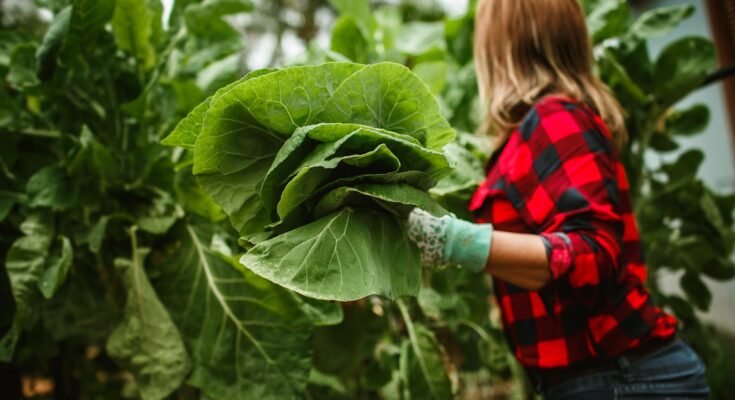Grow Green: Eco-Friendly Backyard Gardening Tips for Sustainable U.S. Homeowners
Introduction: Eco-Friendly Backyard Gardening Tips for Sustainable U.S. Homeowners
Welcome to a comprehensive guide on eco-friendly backyard gardening tips tailored for sustainable homeowners in the U.S. In today’s world, where environmental consciousness is on the rise, more individuals are turning to sustainable practices like gardening to reduce their carbon footprint. By implementing eco-friendly techniques, homeowners can create a vibrant garden while minimizing their impact on the environment.
**Grow Green** explores innovative ways to cultivate a garden that not only beautifies your home but also supports the ecosystem. From utilizing organic fertilizers to implementing water-saving strategies, this blog post delves into the various methods that homeowners can adopt to promote sustainability in their backyard.
Key Takeaways:
- Embracing organic gardening practices can enhance soil health and reduce chemical runoff.
- Implementing water conservation techniques such as drip irrigation systems can help minimize water wastage.
- Integrating native plants in your garden promotes biodiversity and attracts beneficial pollinators.
Join us on a journey to transform your backyard into a green oasis while contributing to a more sustainable future for our planet.
Key Takeaways
- 1. Opt for native plants to promote biodiversity and support local wildlife.
- 2. Implement water-saving techniques such as drip irrigation or rainwater harvesting to conserve resources.
- 3. Use organic fertilizers and natural pest control methods to maintain a healthy ecosystem.
- 4. Create a composting system to reduce waste and enrich the soil with nutrient-rich organic matter.
- 5. Incorporate sustainable hardscaping materials like reclaimed wood or recycled plastic for pathways and garden structures.

Introduction to Eco-Friendly Backyard Gardening
When it comes to sustainable living, eco-friendly backyard gardening stands out as a practical and rewarding way for U.S. homeowners to contribute positively to the environment. By embracing eco-conscious practices in their outdoor spaces, individuals not only create beautiful landscapes but also play a crucial role in promoting biodiversity, conserving resources, and reducing their ecological footprint.
Importance of Eco-Friendly Backyard Gardening
Eco-friendly backyard gardening holds significant importance in the quest for a greener and healthier planet. By avoiding harmful chemicals and pesticides, gardeners protect the soil, water, and air from pollution. This environmentally conscious approach fosters a harmonious ecosystem where beneficial insects, birds, and other wildlife can thrive, creating a balance that sustains life in the long run.
Benefits of Sustainable Gardening for U.S. Homeowners
- Enhanced Sustainability: Sustainable gardening practices help homeowners reduce waste, conserve water, and support local biodiversity.
- Healthier Living Spaces: By growing organic produce, individuals can enjoy fresh, nutritious fruits and vegetables free from harmful residues.
- Cost Savings: Embracing eco-friendly gardening techniques can lead to lower utility bills, reduced maintenance expenses, and overall savings for homeowners.
Impact of Eco-Friendly Practices on the Environment
The impact of eco-friendly practices extends beyond individual gardens to make a collective difference in the environment. Through methods such as composting, mulching, and water conservation, sustainable gardeners contribute to carbon sequestration, soil enrichment, and overall ecosystem health. As every small action adds up, these practices play a crucial role in mitigating climate change and preserving natural resources for future generations.
As author and environmentalist Wendell Berry once said, “The care of the Earth is our most ancient and most worthy, and after all, our most pleasing responsibility.” This sentiment encapsulates the essence of eco-friendly backyard gardening – a fulfilling journey that not only nurtures plants but also nurtures the planet we call home.
Essential Steps to Begin Eco-Friendly Gardening
When embarking on the journey of eco-friendly gardening, there are several essential steps that homeowners in the U.S. should consider to ensure a sustainable and thriving garden.
Choosing the Right Location for Your Garden
One of the first steps in starting an eco-friendly garden is selecting the optimal location. Choose a spot that receives ample sunlight and has good drainage to promote plant growth. Consider the proximity to water sources to facilitate efficient watering practices.
Understanding Your Soil and Climate
Before planting, it is crucial to assess the quality of your soil and understand the climate of your region. Conduct a soil test to determine its pH levels and nutrient content. This information will help you select plants that are well-suited to your soil type and climate, promoting their health and longevity.
Selecting Native Plants and Biodiversity
Opting for native plants is key to promoting biodiversity and supporting local ecosystems. Native plants are adapted to the region’s specific conditions, requiring less water and maintenance compared to exotic species. By incorporating a variety of plants, you can attract beneficial insects and pollinators, creating a balanced and sustainable garden ecosystem.
Implementing Water Conservation Techniques
Water conservation is a fundamental aspect of eco-friendly gardening. Embrace techniques such as mulching to retain soil moisture, using rain barrels to collect rainwater for irrigation, and installing drip irrigation systems for targeted watering. These practices not only conserve water but also promote plant health by providing consistent moisture levels.
In conclusion, by following these essential steps, homeowners can kickstart their eco-friendly gardening journey with a solid foundation. Through mindful planning and sustainable practices, creating a green and thriving garden is not only achievable but also beneficial for the environment.

Designing Your Eco-Friendly Backyard Garden
When it comes to creating an eco-friendly backyard garden, U.S. homeowners can implement various strategies that not only enhance the beauty of their outdoor space but also contribute to sustainability efforts. Here are some essential tips for designing a green garden:
Incorporating Permaculture Principles
One effective way to design an eco-friendly backyard garden is by incorporating permaculture principles. This approach focuses on working with nature rather than against it, emphasizing the importance of sustainable and self-sufficient ecosystems. By designing your garden based on permaculture ethics such as care for the earth, care for people, and fair share, you can create a harmonious and productive outdoor space.
Utilizing Composting and Mulching
Composting and mulching are key practices in sustainable gardening. Composting organic waste not only reduces landfill contributions but also produces nutrient-rich soil for your plants. By incorporating a composting system into your garden routine, you can recycle kitchen scraps and yard waste effectively. Additionally, using mulch helps retain moisture in the soil, suppresses weed growth, and improves overall soil health.
Creating Habitat for Beneficial Insects and Wildlife
Encouraging biodiversity in your backyard garden is essential for maintaining a healthy ecosystem. By planting a variety of native plants, you can attract beneficial insects like bees, butterflies, and ladybugs, which play a crucial role in pollination and pest control. Creating habitats such as birdhouses, bee hotels, and butterfly feeders further supports wildlife conservation efforts and adds charm to your garden.
Integrating Rainwater Harvesting Systems
Water conservation is a critical aspect of eco-friendly gardening. Installing rainwater harvesting systems, such as rain barrels or underground cisterns, allows you to collect and store rainwater for irrigation purposes. By utilizing harvested rainwater in your garden, you can reduce reliance on municipal water sources and minimize runoff pollution.
By following these eco-friendly gardening tips and incorporating sustainable practices into your backyard garden design, you can create a beautiful, thriving outdoor oasis while contributing to a greener and more sustainable future.
Natural Ways to Manage Pests in Your Garden
When maintaining an eco-friendly backyard garden, managing pests naturally is crucial to uphold sustainability practices. Here are some effective methods to keep your garden free from harmful insects while preserving the environment:
1. Beneficial Insects for Pest Control
Introducing beneficial insects like ladybugs, lacewings, and praying mantises can help control pest populations in your garden. These natural predators feed on common garden pests, such as aphids, caterpillars, and mites, without causing harm to your plants.
2. Companion Planting Techniques
Companion planting involves growing certain plants together to deter pests or attract beneficial insects. For example, planting marigolds alongside vegetables can repel nematodes, while growing herbs like basil and mint can discourage aphids and beetles.
3. DIY Organic Pest Repellents
Create organic pest repellents using household ingredients like garlic, neem oil, or chili pepper. These natural solutions can effectively deter pests without introducing harmful chemicals to your garden. Regularly spraying these repellents on your plants can help prevent infestations.
4. Preventing Common Garden Pests
Implement preventive measures to reduce the risk of pest infestations in your garden. Simple practices like removing weeds, rotating crops, and maintaining proper plant spacing can make your garden less attractive to pests. Additionally, regularly inspecting your plants for signs of pest damage can help you address issues early on.
By incorporating these natural pest management strategies into your gardening routine, you can maintain a healthy and thriving garden while minimizing the use of synthetic pesticides. Embracing eco-friendly practices not only benefits your garden but also contributes to a more sustainable environment.
Tips for Maintaining an Eco-Friendly Garden
Maintaining an eco-friendly garden involves adopting practices that promote sustainability and protect the environment. Here are some essential tips for homeowners looking to cultivate a green and thriving garden without the use of harmful chemicals:
Weeding Strategies without Harmful Chemicals
When dealing with weeds, opt for natural and non-toxic weed control methods such as hand weeding, mulching, or using homemade organic weed killers. Regularly inspect your garden for weeds and remove them promptly to prevent them from competing with your plants for nutrients and sunlight.
Pruning and Trimming for Plant Health
Proper pruning and trimming are vital for maintaining plant health and promoting growth. Regularly trim dead or overgrown branches to improve air circulation and sunlight exposure. Remember to use sharp and clean tools to avoid damaging the plants and spreading diseases.
Proper Waste Management Practices
Implement efficient waste management practices in your garden by composting organic waste such as kitchen scraps, leaves, and grass clippings. Compost not only reduces landfill waste but also enriches the soil with valuable nutrients, improving overall soil health and fertility.
Seasonal Garden Maintenance Checklist
To keep your eco-friendly garden in top shape throughout the year, create a seasonal maintenance checklist. This checklist may include tasks such as soil testing, watering schedule adjustments based on weather conditions, planting seasonal vegetables and flowers, and monitoring for pests and diseases.
By following these tips for maintaining an eco-friendly garden, homeowners can create a sustainable outdoor space that benefits the environment and enhances the beauty of their property.
*Remember, a healthy garden is a reflection of a healthy environment.*
Date: August 25, 2024.
Maximizing Yield and Storing Garden Produce
When it comes to eco-friendly backyard gardening, maximizing yield and properly storing garden produce are essential steps for sustainable U.S. homeowners. By implementing optimal harvesting techniques and effective preservation methods, you can enjoy the fruits of your labor year-round while reducing food waste.
Optimal Harvesting Techniques
- Harvest fruits and vegetables at their peak ripeness to ensure the best flavor and nutritional content.
- Use sharp garden shears or knives to prevent damage to plants and promote healthy regrowth.
- Harvest leafy greens and herbs frequently to encourage continuous growth throughout the season.
Methods for Preserving Fruits and Vegetables
Preserving excess garden produce is a great way to extend the shelf life of your harvest. Consider these options:
- Canning: Use a water bath or pressure canner to preserve fruits, vegetables, and sauces for long-term storage.
- Freezing: Quickly freeze berries, peas, beans, and other produce by spreading them on a baking sheet before transferring to freezer-safe containers.
- Drying: Dehydrate herbs, fruits, and vegetables using a dehydrator or by air-drying for a cost-effective preservation method.
DIY Natural Preservation Methods
For those looking to avoid artificial preservatives, consider these natural preservation methods:
“Pickling vegetables in vinegar or fermenting them with salt and water are traditional ways to preserve produce without chemicals.”
Additionally, creating homemade jams, jellies, and fruit preserves can be a fun and flavorful way to enjoy your garden bounty throughout the year.
Creating a Year-Round Supply from Your Garden
By combining optimal harvesting practices with effective preservation techniques, you can create a year-round supply of fresh produce from your garden. Rotate crops, stagger planting times, and diversify your harvest to ensure a continuous abundance of fruits and vegetables.
Remember, sustainable gardening is not just about growing food—it’s also about using resources wisely and reducing waste. By maximizing yield and storing garden produce efficiently, you can embrace eco-friendly practices while enjoying the delicious rewards of your labor.
Learning and Sharing Eco-Friendly Gardening Practices
Embracing eco-friendly gardening practices goes beyond just tending to your backyard – it’s about actively participating in a sustainable lifestyle and sharing knowledge with others. Here are some ways homeowners can learn and share these practices:
Online Platforms for Sustainable Gardening
Utilize online platforms such as gardening forums, social media groups, and websites dedicated to sustainable gardening. These platforms offer a wealth of information, from organic pest control methods to water conservation techniques. Joining these communities allows homeowners to connect with like-minded individuals, share experiences, and stay updated on the latest trends in eco-friendly gardening.
Local Workshops and Gardening Events
Attend local workshops and gardening events focused on sustainability. These gatherings provide opportunities to learn from experts, participate in hands-on activities, and gain practical skills that can be applied in your own backyard. Engaging with local initiatives also fosters a sense of community and encourages collaboration towards a greener environment.
Engaging with Neighborhood Sustainability Initiatives
Get involved in neighborhood sustainability initiatives that promote eco-friendly practices, such as community gardens, composting programs, or tree planting projects. By actively participating in these initiatives, homeowners can not only learn from others but also contribute to the collective effort of making the neighborhood more environmentally conscious.
Teaching Children About Eco-Friendly Gardening
Instilling eco-friendly values in children is key to fostering a sustainable future. Take the opportunity to involve children in gardening activities, teaching them the importance of using organic fertilizers, conserving water, and attracting beneficial insects to the garden. By passing down eco-conscious practices to the next generation, homeowners can ensure a legacy of environmental stewardship.
By actively engaging in learning and sharing eco-friendly gardening practices, U.S. homeowners can make a meaningful contribution to sustainable living and inspire others to follow suit.
Assessing the Sustainability of Your Garden
Creating an eco-friendly backyard garden is a fantastic way for homeowners to contribute to a more sustainable environment. To ensure your garden is truly sustainable, it’s essential to regularly assess various factors that impact its overall ecological footprint.
Tracking Water and Energy Usage
One crucial aspect of assessing your garden’s sustainability is monitoring water and energy consumption. Keep a record of how much water you use for irrigation and consider implementing water-saving techniques such as drip irrigation or rainwater harvesting. Additionally, opt for solar-powered garden lights to reduce energy consumption.
Monitoring Soil Health and Biodiversity
Healthy soil is the foundation of a sustainable garden. Conduct soil tests periodically to assess its quality and nutrient levels. Embrace organic gardening practices to promote biodiversity by planting a variety of native plants that attract pollinators and beneficial insects.
Evaluating Carbon Footprint Reduction
Reducing your garden’s carbon footprint is another key element of sustainability. Choose hand tools over gas-powered ones, compost kitchen scraps to minimize waste, and avoid synthetic fertilizers and pesticides that contribute to greenhouse gas emissions.
Setting Long-Term Eco-Friendly Gardening Goals
Setting specific eco-friendly goals will help guide your sustainability efforts. Whether it’s reducing water usage by 20% within the next year or increasing native plant diversity, having clear objectives can drive positive change in your garden.
As 2024-08-25 approaches, remember that sustainability is an ongoing journey. By regularly assessing and improving these key aspects of your garden, you can create a thriving and environmentally friendly outdoor space that benefits both your household and the planet.
Conclusion
As homeowners strive to embrace sustainable living, eco-friendly backyard gardening emerges as a practical and rewarding solution. From the initial steps of setting up a garden to managing pests naturally and maximizing yield, this blog post has provided invaluable insights into creating an environmentally conscious outdoor space. By designing a garden with biodiversity in mind and sharing eco-friendly practices within the community, individuals can contribute to a greener future.
Key Takeaways:
- *Essential Steps*: Start with composting and selecting native plants.
- *Pest Management*: Use companion planting and beneficial insects.
- *Yield Optimization*: Implement crop rotation and proper storage techniques.
- *Community Engagement*: Learn from others and spread eco-conscious gardening methods.
Remember, sustainable gardening is not just about the end result but also about the journey towards a healthier planet. By assessing the sustainability of their gardens regularly, homeowners can make informed decisions to further enhance their eco-friendly practices. Let’s cultivate our green spaces with care and dedication for a more sustainable tomorrow.
Frequently Asked Questions
1. Why is eco-friendly backyard gardening important for sustainable living?
Eco-friendly backyard gardening helps reduce carbon footprint, promotes biodiversity, and minimizes the use of harmful chemicals, contributing to a healthier environment for future generations.
2. What are some benefits of implementing sustainable gardening practices?
By adopting sustainable gardening practices, homeowners can conserve water, improve soil health, attract pollinators, and enjoy fresh, organic produce right from their backyard.
3. How can U.S. homeowners start their eco-friendly backyard garden?
To begin an eco-friendly backyard garden, homeowners can start by assessing their space, choosing native plants, composting kitchen waste, and using natural pest control methods to create a thriving and sustainable garden ecosystem.
4. What are some common challenges faced by those new to eco-friendly gardening?
Some common challenges for beginners in eco-friendly gardening include dealing with pests organically, maintaining proper soil health, and understanding the specific needs of different plant species.
5. Is it possible to have a visually appealing backyard garden while still being eco-friendly?
Absolutely! Homeowners can create visually stunning gardens by incorporating colorful native plants, utilizing creative landscaping designs, and repurposing materials, all while adhering to eco-friendly principles.


